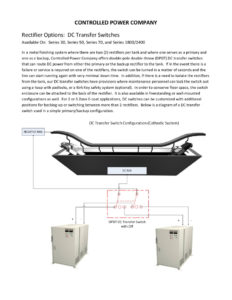Series 30 Rectifier
Description:
The Series 30 is a primary SCR, single transformer, DC power supply for low voltage plating/anodizing applications. It is available in air- or water-cooled configurations; plus NEMA 1, NEMA 2, NEMA 3R, or NEMA 4X enclosure ratings.
Input voltages ranging from 208V – 600VAC, three phase 60Hz or 50Hz
Input AC Voltage: 208V – 600V
Output DC Voltage Range: 6V – 100V
Output DC Current Range: 500A – 10,000A

- Highly efficient all-copper transformer construction
- Standard remote control panel
- Air- or water-cooled flexibility
- Domestic and international voltage capability
- Low ripple
- Tight voltage and current regulation
- Diagnostic options for ease of maintenance
- Input Line Variation: +/- 5% from nominal (± 10% optional)
- Output Voltage Regulation: ± 0.5%
- Output Current Regulation: ± 0.5%
- AC RMS Output Ripple at Full Voltage and Current: 5% RMS
- Optional AC RMS Output Ripple at Full Current: 1% or 5% @ 25% to 100% output voltage
- Efficiency 85% – 90%
- Plating
- Anodizing
- Electro-machining
- Testing
- Electro-winning
- Electro-galvanizing
Learn more about this product! Read our brochures and other supporting documents!
- How can I reduce or eliminate downtime?
- What size rectifier do I need?
- Which is better: air- or water-cooling?
- What is the advantage of a primary SCR, single transformer design?
- Do I need a ripple filter?
- Which leg of the rectifier is grounded?
- Can I control or monitor the rectifier with my PLC?
- How can I reduce the floor space needed for rectifiers used in my process?
- Do I need a separate feeder transformer for the rectifier?
- When do I need a DC switch?
- How can I increase my rectifier current output?
Warranty
Controlled Power Company warrants the Series 30 Rectifier to be free from defects in material and workmanship for a period of two (2) years following shipment from the factory. Controlled Power Company agrees to replace, F.O.B. its factory, any parts which fault through defect in material or workmanship during the warranty period.
Consult the factory for additional warranty details, and a description of start-up services provided.












